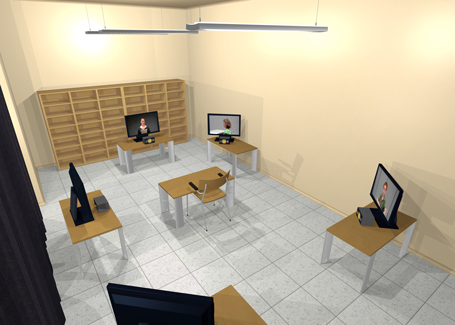Comparing Head Rotation Angle, Visual Localization,
and Recall-proficiency of School-aged Children (8-12) While Listening to a Story
by Multiple Discreet Talkers in a Virtual Classroom
Daniel L. Valente - daniel.valente@boystown.org
Dawna
Lewis
John
Franco
Elizabeth
Heinrichs
Hearing
Research
Boys
Town National Research Hospital
Omaha,
NE 68106, USA
Popular
version of paper 2pAAa9
Presented Tuesday Afternoon, Apr 20, 2010
159th ASA Meeting, Baltimore, MD
Its
well known that children perform more poorly than adults when listening to
speech in noisy environments such as classrooms. This can be made worse when
the talker is located to the side or behind the student. While previous
research has been conducted in acoustic envirommnents that mimic real
classrooms, the tasks used to test listeners often have been limited to a
single talker located in front of the subject,which is not typical of many
classroom interactions. In this investigation, both elementary-aged (8-12) and
adult normal-hearing listeners were presented with a classroom learning task
with a more realistic arrangement of talkers (located around the listener, as
in a typical classroom).
Differences
in comprehension performance were seen between children and adults in both
multiple and single talker classroom learning tasks that were not found in a
simple speech intelligibility test. It was also found that children exhibited
poorer comprehension performance in the multiple vs. single talker classroom learning
tasks whereas adults exhibited similar performance regardless of the task. The
plausible classroom environment illuminates differences in performance between
children and adults as well as type of learning task that are not seen in a
standard test of the intelligibility of speech.
The
experiment featured several novel set-up attributes. First, a virtual classroom
was created in a lab at the Boys Town Research Hospital. A 3-D rendering of the
classroom setup can be seen in Figure 1.
By using a combination of acoustic treatment and virtual room-model
techniques, a classroom was created that had the same levels of background
noise and sound decay (reverberation) as an ideal classroom. This yielded an environment in which both
children and adults were able to score over 95% on a sentence perception task.

Figure 1. Virtual classroom environment.
An
array of five LCD monitors and loudspeakers reproduced the audio-visual
information to a subject that sat in the middle of the classroom. Finally, since
it was of interest to monitor the subjects looking behavior throughout the task,
a gyroscopic head-tracker was used to record head movements.
Classroom
learning task:
Forty
children and 40 adults with normal hearing participated in the study. Half of
the subjects in each group listened to an 11-minute elementary-age appropriate readers-theater
play read by a teacher and four students reproduced over the LCD monitors
(multi-talker). For the other half of the subjects, the play was read by the
teacher (single talker). At the end of the play, subjects were asked a series
of 18 questions to assess their comprehension of the play. In general, children performed more poorly
than adults in both listening conditions. In addition, a significant effect of
age was seen for both the multi-talker and single-talker tasks.

Figure 2. Comprehension scores for the multi- and
single-talker conditions of the classroom listening task.
To
examine looking behavior when there are multiple talkers, results of gyroscopic
measurements were analyzed. In general, both age groups localized the
individual talkers less than 50% of the time, with children looking directly at
the talkers as they spoke significantly more often than adults (Figure 3).
However, when general looking behavior was analyzed, children were much more
likely to try to look in the direction of individual talkers than adults.

Figure 3. Proportion of talkers localized for
child and adult listeners in the multi-talker condition of the classroom
listening task.
In
this experiment we found that children differed from adults in both the multi- and
single-talker conditions. Children performed more poorly in conditions where
there were multiple talkers, while adults had similar performance in both
conditions. It was found that despite the fact that children looked toward the
individual talkers more often than adults, their comprehension scores were
still poorer.
Ongoing
studies are being conducted using the virtual classroom and experimental
technique to examine other populations, such as children with hearing
loss. Conditions that include a higher level
of noise or longer reverberation are also being studied as well as using hearing
assistance technologies in the environment.